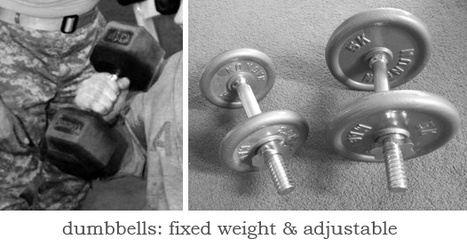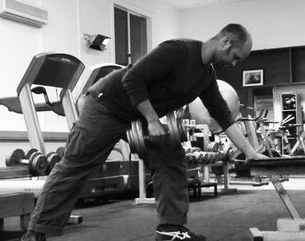 The best fitness gadgets you can buy are going to be simple and versatile. But because of their versatility, you’re going to need to educate yourself as to their usage. Ab gizmos that have only one purpose are easy to use, but they don’t give you much bang for your buck, because you’ll spend a lot of money on equipment that really only has a single use, and as much as that makes it simple to use it also makes it kind of useless. You can’t train your legs with a crunch machine, for example. The application is very narrow. A pair of dumbbells, however, is handy and versatile. The equipment itself is simple and cheap, and if you’re going to have exercise equipment laying around that you don’t use, it might as well be cheap stuff. Bearing that in mind, it can be quite easy to pick up used dumbbells that someone else has forgotten about and not been using. When it comes to used exercise equipment, you might not know what you can trust. But if a dumbbell is broken, you can tell. The iron is just as heavy as it was the day it was bought, if the handle is straight you’re doing fine, and that’s pretty much all you need to worry about. On one hand, I like used weights. I think of them as having good feng shui. Good energy. If they’ve been used a lot, they’ve helped make other people strong, and there’s something special in that. These days, strongman training is in fashion again. People train sledgehammer swings, tyre flips, and lifting atlas stones – which is simply a heavy stone that’s smooth and spherical. The essence of strongman training is clearly in everyday implements – you use what you have that’s handy as a training device. I once saw a video online of a woman in America doing her fitness training. She put on her heavy firefighter suit and pushed a small truck along her long, incredibly long gravel driveway. Did a bunch of other body-weight exercises too. You work with what you’ve got. She wasn’t a model, and was totally badass. Wish I could find that clip, but it wasn’t on youtube, and I don’t know where to look. On the simplest level, strength training amounts to picking up something heavy and repeating it til you can’t repeat no more. Cardiovascular conditioning is about doing that quickly, maybe with something a little lighter.  Kettlebells were essentially weights used to weigh stuff. Grain, whatever. You’d get some big-ass scales, put a kettlebell on one side, and load grain on the other until they’re level and you know how much grain you’ve got. Now we use them for strength and cardiovascular training, because they’re compact and they’ve got a cool handle. But the essence of the training is really in making the most of what you happen to already have. Barbells too – all these tools are called “free weights” because they move freely in space, your motion is not dictated by pullies or tracks that guide the movement of the weights or your body. And that’s kinda the corker – because of their versatility, if you don’t know what you’re doing it’s difficult to know what to do. With a machine or ab gizmo, the correct usage is obvious, but there’s often only one or two things you can do with them. I recently saw an ab machine advertised, and they compared the intensity of the contraction of your abdominal muscles when using their device, as opposed to when you’re practicing a conventional crunch. According to their diagnostics, when using the machine your muscles work harder than they do when you’re doing sit-ups. Now, I like to judge the effectiveness of an exercise as to its capacity to make you stronger, more mobile, or better at moving. But the marketing for this device was geared toward fat loss, so we’ll look at effectiveness in relation to the goal they’re pushing. It is now pretty widely known that practicing crunches or sit-ups isn’t nearly enough to make you thin – so saying that this machine is more effective than an exercise that does not work – well that’s not saying much at all. This is not useful even if it does mean they get away with using the term scientifically proven. Beware misleading science. What works for 78% of a group of 50 young men at college over a period of four months might not work for a post-menopausal woman, a 36 year old with hypothyroidism, or someone who’s been dieting on and off for the last ten years. We make assumptions like crazy. The best dumbbells are actually the ones that require you to be patient. They are not fixed, but adjustable. You can add or subtract weight by loading or unloading plates. This forces you to rest between sets, and increases their versatility. Plus, as you get stronger, it’s cheaper to buy heavier plates than a whole new set of fixed-weight dumbbells. Also, you can simply grab the weight plate and train with it by itself. If you do like sit-ups, and are considering buying an ab gizmo, just buy a five kilogram weight plate instead and hold it on your chest while doing crunches. I tend to think crunches are not a good exercise for most people to do – they can mess with your back – but if you’re going to train your abs a lot, better a cheap iron plate than an expensive machine that does nothing more effective than something simple.  And you can use dumbbells to train any of the following movements: Shoulder Press Single Arm Row (pictured) Curls Lateral and Front Raises Laying Chest Press Incline or Decline Chest Press Triceps Extensions and Kickbacks Squats Lunges Calf Raises Swings Arms, shoulders, back, chest, abs, hips, legs – all body parts are trained. Sometimes people will criticise pink girly weights. They’re too light, they don’t do anything, etc. The advantage to any dumbbell is that you can use exactly what is appropriate for you. Train in the way that is right for you. This is best. Sometimes a light dumbbell is extremely useful, and light does not mean you aren’t training hard. And training hard is often not what’s best – for rehab, it is common to train light, but frequently throughout the week, and even if you are not capable of moving your joints to any great degree under load, simply holding on to a two kilogram dumbbell by the handle for a period of time can help get your rehabilitation under way. Dumbbells are great for strengthening your grip, because they were designed to be easy to hold on to – they are generally neither too thick nor too thin, but made at an optimal shape to allow you to continually add weight to the bar over time, as you progress. All strategies are useful, as long as you’re investigating what’s useful for you. The other advantage people like to emphasise when it comes to free weights is this – learning to move a heavy object through space is great for body awareness and coordination. You naturally train your stabiliser and core musculature, because almost everything you can do with free weights challenges your balance and requires that you learn to stabilise both your own body and the weight with muscular strength, the correct application of tension, and mental focus. It can take a long time to familiarise yourself with these movements. But once you get into the swing of training with dumbbells, you’ll find there is a lot you can do with them, and if you’re wired this way, if you like you can get a good half hour workout happening without having to go anywhere or consult with anyone, and over time, depending on how you feel, you can simply add weight to the bars, and keep challenging yourself. The other thing is, it’s pretty easy to train with dumbbells and not injure yourself. People are often afraid of weightlifting. They think a thing is simply too heavy, and maybe they’re scared, but they’re not thinking about their own body. If a thing is too heavy, don’t focus on the thing, focus on yourself. Adjust your body, pay attention to your joints and muscles, apply leverage best you can, and if you think you’re going to damage something, just stop. Maybe you’ll lift it, maybe you won’t – but if you think about your body and efficient leverage, you’ll keep yourself safe, and there’s no need to fear the heavy object. If you aren’t crazy about it, if you respect your limitations, rather than blindly try to bust through them – if you listen to your body, rather than try to dominate it – you can progress, albeit more slowly than might otherwise be possible, but certainly effectively. And of course, it’s good to remind ourselves – equipment is often unnecessary if you want to get a bit fitter or better at moving.
0 Comments
Leave a Reply. |
